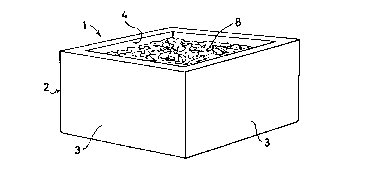Some of the information on this Web page has been provided by external sources. The Government of Canada is not responsible for the accuracy, reliability or currency of the information supplied by external sources. Users wishing to rely upon this information should consult directly with the source of the information. Content provided by external sources is not subject to official languages, privacy and accessibility requirements.
Any discrepancies in the text and image of the Claims and Abstract are due to differing posting times. Text of the Claims and Abstract are posted:
| (12) Patent Application: | (11) CA 2000454 |
|---|---|
| (54) English Title: | WASTE DUMP COMPRISING A STORAGE SPACE WITH IMPERMEABLE WALL OF MATERIAL WITH POZZOLANIC PROPERTIES |
| (54) French Title: | SYSTEME D'EVACUATION DES DECHETS COMPRENANT UN BAC D'ENTREPOSAGE AVEC PAROIS ETANCHES FAITES D'UN MATERIAU A PROPRIETES POUZZOLANES |
| Status: | Deemed Abandoned and Beyond the Period of Reinstatement - Pending Response to Notice of Disregarded Communication |
| (51) International Patent Classification (IPC): |
|
|---|---|
| (72) Inventors : |
|
| (73) Owners : |
|
| (71) Applicants : |
|
| (74) Agent: | SMART & BIGGAR LP |
| (74) Associate agent: | |
| (45) Issued: | |
| (22) Filed Date: | 1989-10-11 |
| (41) Open to Public Inspection: | 1990-04-12 |
| Availability of licence: | N/A |
| Dedicated to the Public: | N/A |
| (25) Language of filing: | English |
| Patent Cooperation Treaty (PCT): | No |
|---|
| (30) Application Priority Data: | ||||||
|---|---|---|---|---|---|---|
|
WASTE DUMP COMPRISING A STORAGE SPACE WITH IMPERMEABLE
WALL OF MATERIAL WITH POZZOLANIC PROPERTIES
Abstract
A waste dump (1) for waste material (8) consisting of
a partially underground tank (2) having rigid hydraulically
set walls (3) with self-restoring capacity when cracks (5)
occur in said walls.
The walls may consist of rigid concrete having on
their inner side a self-restoring layer (4) when cracks
occur, but the walls may also completely consist of such a
self-restoring layer.
The self-restoring capacity of the layer and wall
respectively is obtained by the presence of still
hydraulically settable material with pozzolanic properties
in said hydraulically set layer and/or wall.
The self-restoring layer is formed from ground
granulated blast furnace slag with fine or coarse blast
furnace slag granulate, the ground blast furnace slag may
be partially replaced with ground fly ash and the coarse or
fine blast furnace may be replaced with gravel.
The tank (2) may also be covered by a rigid cover (7)
having the above-mentioned self-restoring properties ob-
tained by means of materials with pozzolanic properties.
Note: Claims are shown in the official language in which they were submitted.
Note: Descriptions are shown in the official language in which they were submitted.

2024-08-01:As part of the Next Generation Patents (NGP) transition, the Canadian Patents Database (CPD) now contains a more detailed Event History, which replicates the Event Log of our new back-office solution.
Please note that "Inactive:" events refers to events no longer in use in our new back-office solution.
For a clearer understanding of the status of the application/patent presented on this page, the site Disclaimer , as well as the definitions for Patent , Event History , Maintenance Fee and Payment History should be consulted.
| Description | Date |
|---|---|
| Inactive: IPC from MCD | 2006-03-11 |
| Inactive: IPC from MCD | 2006-03-11 |
| Inactive: IPC from MCD | 2006-03-11 |
| Inactive: Abandon-RFE+Late fee unpaid-Correspondence sent | 1996-10-11 |
| Inactive: Adhoc Request Documented | 1996-10-11 |
| Time Limit for Reversal Expired | 1995-04-11 |
| Application Not Reinstated by Deadline | 1995-04-11 |
| Deemed Abandoned - Failure to Respond to Maintenance Fee Notice | 1994-10-11 |
| Inactive: Adhoc Request Documented | 1994-10-11 |
| Application Published (Open to Public Inspection) | 1990-04-12 |
| Abandonment Date | Reason | Reinstatement Date |
|---|---|---|
| 1994-10-11 |
Note: Records showing the ownership history in alphabetical order.
| Current Owners on Record |
|---|
| PELT & HOOYKAAS B.V. |
| Past Owners on Record |
|---|
| CAREL W. J. HOOYKAAS |